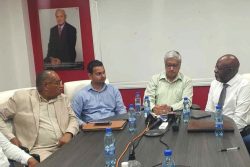Government’s decision to terminate negotiations with the China State Construction Engineering Corporation (CSCEC) raises serious issues of due process, contract evaluation and probity by the administration, the Alliance for Change (AFC) yesterday said.
APNU+AFC Member of Parliament David Patterson, who is former Minister of Public Infra-structure, said the announcement on Tuesday of government terminating talks with the Chinese company is suspicious and requires a proper, detailed and coherent explanation.
In a party statement Patterson said the initial reason given by Vice President Bharrat Jagdeo — that the financing costs were too high — was rubbished by the project evaluation process, which the Cabinet received and granted in a “no-objection” approval to the Ministry of Public Works to engage CSCECL from November 2021 based on a Design-Build-Finance (DBF) model.
“For the country to believe the Vice President now raises questions as to why in November he clearly stated that the financial terms and conditions would be no less favourable than those submitted in the preferred bidder’s price proposal and that the construction cost of US$256.6 million was the lowest among all bidders,” Patterson said.
When contacted last night for a response to Patterson’s concerns, Minister of Public Works Juan Edghill declined to comment on the issue.
Edghill previously told Stabroek News that the decision to move on to the second ranked bidder was based on the financing terms. The terms for the number one bidder were found to be too onerous and Edghill said their terms of repayment would have “strangulated” the country.
Stabroek News understands that government is seeking a company who is willing to offer a fixed interest rate on the project. The last bidder, this newspaper was told, did not want to offer that and had proposed changing interest rates every few years.
Patterson said the announcement’s proximity to corruption questions in the recent VICE Media Group interview with Jagdeo is also curious and of great concern to the Alliance For Change.
In an interview with VICE Media Group, Jagdeo disclosed that the government terminated talks with CSCEC on the grounds that its financing costs were too high.
A decision to terminate the negotiations were made at the start of February.
It is also no secret, Patterson said, that there is great suspicion that one of the contracts referenced by the interviewer is the proposed contract with CSCECL, and there is now a strong belief that the two events signal that there was more to the” mortar than the pestle,” Patterson said.
Against this background he said it was not credible for the sudden termination of negotiations because the financing costs were too high. He called on the engineering and financial advisers to speak on the decision and provide answers to the country.
Patterson said openness and transparency were the only solutions to this conundrum facing the Guyanese, who believe the government’s secrecy posture fuels speculation about the lack of probity within the PPP administration. He said it was important to recall that this project was shovel-ready during the APNU+AFC government, but the new PPP government chose to discard all the work and start all over again.
The termination of negotiations occurred near the start of the month and Edghill told this newspaper that while the proposed cost of the bridge was pegged at over US$256 million, it is likely to change. He however maintained that the evaluating team which consists of a lawyer, engineers, project managers, financial experts and other technical staff, is negotiating for the best deal possible. Quizzed on the negotiations with the China Railway Group, Edghill said their discussions have been progressing and expressed the hope that the negotiations would be concluded in a month’s time. He emphasised that while the wish is for negotiations to be wrapped up in the shortest possible time, securing the best terms for the construction is integral. “We are looking for the best deal… anybody can come and say they are financing but what is the terms of the interest? So we have to get a superior proposal that is compatible with the terms of concessional financing,” Edghill had explained.
CSCEC, in its tender document, pegged the cost for the construction of the bridge at US$256,638,289.
The bidding document had specified the criteria for making a bid on the project. It stipulated that bidders must present proposals for a Design, Build and Finance (DBF) option, or alternatively, Design, Build, Finance, Operate and Maintain (DBFOM).
The Scope of Works in the design/build contract included the complete design and construction of a two-lane dual (four-lane) carriageway, hybrid cable-stayed centre-span bridge with concrete box/T-beam girder approach bridge structures, and must include bridge collision protection, a navigation span to accommodate Handymax vessel navigation aids, lighting, signage, and all other ancillary works, an access road with a minimum of 50 meters up to abutments, toll-collection buildings, and ancillary buildings on the West Bank of the Demerara River.
When completed, government wants a new four-lane, high-span fixed bridge in the vicinity of the current location and which terminates at Nandy Park on the East Bank of Deme-rara. “The new design of the Demerara Harbour Bridge will not require opening or retraction to allow for maritime traffic and will be built with a life span of at least 50 years,” the bidding document stated.






